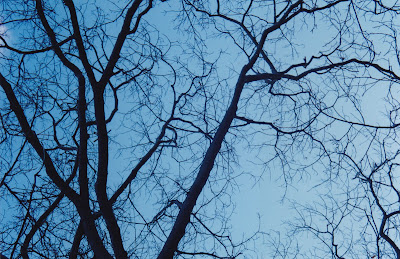 |
| Bare winter trees. |
It’s 4 p.m., and as I look into the trees outside my office window, I see nothing but darkness. The sun has not yet set, but heavy thunderclouds conceal what weak light remains in the dull December sky. Another fleeting late autumn day has passed.
In these weeks approaching the Winter Solstice, I am acutely aware of nature’s cyclical rhythms — the days growing shorter, the nights growing longer. Despite my thirst for vibrant sunshine, I find the encroaching darkness somewhat comforting.
The Winter Solstice — known in some traditions as The Shortest Day — serves as a balancing point for the year. The days grow increasingly short as it approaches, then once the Solstice has passed, they begin to grow longer again. “Just make it through till Solstice . . . ” I tell myself. The fact that each succeeding day will bring an additional minute or so of sunlight takes the some of the bite out of the long, cold winter.
One of my family’s annual holiday traditions is to attend The Christmas Revels, at Harvard University’s Sanders Theater, on the Sunday before Christmas. While the theme of Revels — a celebration of the Winter Solstice featuring music, dance and drama — changes from year to year, certain segments of the show are always repeated.
One of my favorites among these is the story of Saint George and the Dragon, a medieval Mummers’ play that celebrates the cycle of fertility, death and rebirth. In the play, Saint George battles and slays a dragon. However his triumph is short lived, as soon after he too is killed, falling victim to the sword dancers, whose interlocking weapons represent the sun and the slaying of the old so that the new may spring to life.
While Saint George lies dead at center stage, the dancers continue to move around him, their swords clicking, the bells attached to their boots ringing with each intricate step. A doctor is summoned, and after some effort, George is brought back to life. A new year has begun. The players leave the stage cheering.
“Lord of the Dance,” a traditional number which celebrates the life, death and resurrection of Christ, follows shortly thereafter. As the audience sings the song’s simple “Dance, then, whoever you may be” chorus, the cast forms a procession leading off the stage and into the great hall. The audience members, still singing, are encouraged to rise from their seats, to take each others’ hands, and to join in the dance. The chorus is repeated until the hall is packed so tight with people that no one can move, and still singing, all are obliged to smile or catch the eye of the stranger standing next to them. At that point, only the chilliest of souls could manage not to feel at least a twinge of Christmas spirit.
The custom of setting lights ablaze to mark the beginning of winter is one that can be attributed to any number of religious faiths. Perhaps no single tradition may lay claim to being the first to do it; no doubt there are countless different stories behind the derivation of the ritual. In many cases it’s about bringing light to the darkness as winter begins — an affirmation of hope on the longest, darkest night of the year.
I’ve spent a fair amount of time in church, but I’d stop short of calling myself religious. One thing I especially enjoy about The Christmas Revels is the way it unites a number of different religious and spiritual traditions in its celebration of the Solstice, a natural event that –whether we choose to acknowledge it or not — we all share.
Attending a church service more often than not makes me squirm, but the songs, dances, and stories of The Christmas Revels — whether their origins are Christian or Pagan or otherwise — renew my faith in mankind and our ability, despite differences of faith and philosophy, to coexist on this planet in relative peace. The ritual singing, in the second act of Revels, of “Dona Nobis Pacem” is generally the high point of my spiritual year: it’s the time when I feel most connected to the rest of the world, as — doing my best to hit the high notes — I join my voice with those of a thousand others, singing out our prayer for peace.
The sun has fully set now, and beyond the trees outside my window my neighbors have turned on their Christmas lights — mostly white, with accents of red and green. In a minute I’ll go downstairs and illuminate my family’s own holiday tree. Then, sitting for awhile, I’ll admire its brightness, and the light and warmth it brings to these cold, dark days.
by Kezia Bacon, Correspondent
December 1998
Kezia Bacon’s articles are provided by the North and South Rivers Watershed Association.
